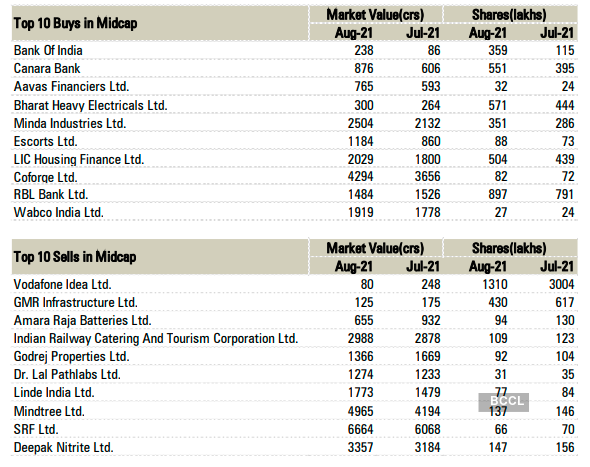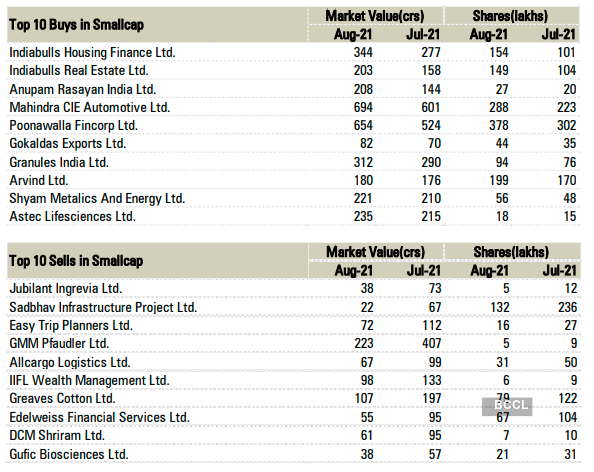|
Today, the Reserve Bank released the results of the 2020-21 round of the Survey of Foreign Liabilities and Assets of the Mutual Fund (MF) Companies[1].
The survey covered 44 Indian MF companies and their Asset Management Companies (AMCs), which held/acquired foreign assets/ liabilities during 2020-21 and/or in the preceding year (list given in the Annex). The stock of external assets and liabilities of their AMCs is taken from the annual census on foreign liabilities and assets of direct investment companies and the information on face value and market value of units held by non-resident, unit premium reserve and other foreign liabilities were collected under Schedule 4.
Highlights:
I. Mutual Fund Companies:
-
Foreign liabilities of MF companies stood at US $14.5 billion in March 2021, which were mainly in form of units issued to non-residents. Foreign assets of MF companies increased due to rise in equity security and other foreign assets during the year and stood at US $ 2.9 billion at end-March 2021 (Table 1).
-
UAE, UK, USA and Singapore together accounted for nearly 45 per cent of the total MF units held by non-residents, both at face value as well as at market value (Table 2 and 3).
-
Overseas equity investments of MF companies were largely concentrated in the USA and Luxembourg (Table 4).
II. Asset Management Companies:
-
Foreign liabilities of AMCs stood at US $ 5.7 billion in March 2021 whereas their foreign assets were much lower at US $ 0.1 billion (Table 5).
-
Non-residents in Japan and UK together held nearly 89 per cent of FDI of the AMCs (Table 6).
-
The relatively small overseas investments by AMCs were largely held in Guernsey, Singapore and Mauritius (Table 7).
(Yogesh Dayal)
Chief General Manager
Press Release: 2021-2022/866
| Table 1: Mutual Fund Companies – Foreign Liabilities and Assets |
| Item |
End-March 2020 (R) |
End-March 2021 (P) |
% Growth
(₹ terms) |
| ₹ crore |
US$ million |
₹ crore |
US$ million |
| 1 |
2 |
3 |
4 |
5 |
6 |
| Foreign Assets |
5,864 |
778 |
20,982 |
2,854 |
257.8 |
| (a) Equity Securities |
5,808 |
770 |
20,865 |
2,839 |
259.3 |
| (b) Debt Securities |
– |
– |
– |
– |
– |
| (c) Other Foreign Assets |
56 |
8 |
117 |
16 |
108.9 |
| |
|
|
|
|
|
| Foreign Liabilities |
72,564 |
9,626 |
106,249 |
14,455 |
46.4 |
| (a) Market Value of Units |
72,366 |
9,599 |
106,069 |
14,430 |
46.6 |
| (b) Other Foreign Liabilities |
198 |
26 |
180 |
24 |
-9.0 |
| |
|
|
|
|
|
| Net Liabilities |
66,700 |
8,848 |
85,267 |
11,600 |
27.8 |
| Face Value of Units |
31,184 |
4,137 |
34,348 |
4,673 |
10.1 |
Notes: 1. The amount in US $ terms is arrived at by using the RBI reference rate (end-March).
2. Liabilities / Assets are valued at market prices unless stated otherwise.
3. Sum of constituent items may not add up to total due to rounding off.
4. – Nil/negligible.
5. R: Revised; P: Provisional.
6. These are also applicable for the remaining tables. |
| Table 2: Foreign Liabilities in Units of MF Companies at Face Value – Major Countries |
| (Amount in ₹ crore) |
| Country |
End-March 2020 (R) |
End-March 2021 (P) |
% Share in 2021 |
Annual Variation |
| Absolute |
Per cent |
| 1 |
2 |
3 |
4 |
5 |
6 |
| United Arab Emirates |
5,640 |
6,376 |
18.6 |
736 |
13.0 |
| United Kingdom |
3,300 |
3,538 |
10.3 |
238 |
7.2 |
| United States of America |
2,898 |
3,093 |
9.0 |
195 |
6.7 |
| Singapore |
2,094 |
2,184 |
6.4 |
91 |
4.3 |
| Oman |
821 |
931 |
2.7 |
110 |
13.5 |
| Qatar |
614 |
797 |
2.3 |
183 |
29.8 |
| Hong Kong |
783 |
670 |
2.0 |
-113 |
-14.4 |
| Saudi Arabia |
553 |
645 |
1.9 |
92 |
16.6 |
| Kuwait |
544 |
629 |
1.8 |
85 |
15.6 |
| Mauritius |
600 |
486 |
1.4 |
-114 |
-19.0 |
| Others* |
13,338 |
14,999 |
43.6 |
1,661 |
12.5 |
| Of which: India |
6,858 |
7,819 |
23.0 |
961 |
14.0 |
| Total |
31,184 |
34,348 |
100.0 |
3,164 |
10.1 |
| *Others (comprised 241 countries) also includes non-resident Indians (NRIs), who use their Indian permanent address. |
| Table 3: Foreign Liabilities in Units of MF Companies at Market Value – Major Countries |
| (Amount in ₹ crore) |
| Country |
End-March 2020 (R) |
End-March 2021 (P) |
% Share in 2021 |
Annual Variation |
| Absolute |
Per cent |
| 1 |
2 |
3 |
4 |
5 |
6 |
| United Arab Emirates |
12,247 |
19,232 |
18.1 |
6,985 |
57.0 |
| United States of America |
7,836 |
11,575 |
10.9 |
3,739 |
47.7 |
| United Kingdom |
6,616 |
9,565 |
9.0 |
2,949 |
44.6 |
| Singapore |
5,324 |
7,365 |
6.9 |
2,041 |
38.3 |
| Mauritius |
2,915 |
3,477 |
3.3 |
562 |
19.3 |
| Oman |
1,794 |
2,848 |
2.7 |
1,052 |
58.6 |
| Qatar |
1,369 |
2,534 |
2.4 |
1,165 |
85.1 |
| Kuwait |
1,237 |
1,961 |
1.9 |
724 |
58.5 |
| Saudi Arabia |
1,159 |
1,949 |
1.8 |
790 |
68.2 |
| Hong Kong |
1,501 |
1,807 |
1.7 |
307 |
20.4 |
| Others* |
30,368 |
43,756 |
41.3 |
13,391 |
44.1 |
| of which: India |
16,155 |
21,592 |
20.4 |
5,438 |
33.7 |
| Total |
72,366 |
106,069 |
100.0 |
33,703 |
46.6 |
| *Others (comprised 241 countries) also includes non-resident Indians (NRIs), who use their Indian permanent address. |
| Table 4: Equity Securities held Abroad by Mutual Fund Companies at Market Value– Major Countries |
| (Amount in ₹ crore) |
| Country |
End-March 2020 (R) |
End-March 2021 (P) |
% Share in 2021 |
Variation |
| Absolute |
Per cent |
| 1 |
2 |
3 |
4 |
5 |
6 |
| United States of America |
2,427 |
9,029 |
43.3 |
6,602 |
272.0 |
| Luxembourg |
2,536 |
8,867 |
42.5 |
6,331 |
249.6 |
| Ireland |
89 |
1,469 |
7.0 |
1,380 |
1550.6 |
| Japan |
125 |
340 |
1.6 |
215 |
172.0 |
| Canada |
180 |
308 |
1.5 |
128 |
71.1 |
| Cayman Islands |
83 |
287 |
1.4 |
204 |
245.8 |
| United Kingdom |
69 |
112 |
0.5 |
43 |
62.3 |
| Taiwan |
30 |
82 |
0.4 |
52 |
173.3 |
| Hong Kong |
22 |
66 |
0.3 |
44 |
200.0 |
| Singapore |
35 |
58 |
0.3 |
23 |
65.7 |
| Others |
212 |
247 |
1.2 |
35 |
17.5 |
| Total |
5,808 |
20,865 |
100.0 |
15,057 |
259.2 |
| Table 5: Foreign Liabilities and Assets of AMCs |
| Item |
End-March 2020 (R) |
End-March 2021 (P) |
% Growth
(₹ terms) |
| ₹ crore |
US$ million |
₹ crore |
US$ million |
| 1 |
2 |
3 |
4 |
5 |
6 |
| Foreign Liabilities |
33,300 |
4,417 |
42,257 |
5,750 |
26.9 |
| (a) Direct Investment |
28,130 |
3,731 |
34,279 |
4,664 |
21.9 |
| (b) Portfolio investment |
5,141 |
682 |
7,974 |
1,085 |
55.1 |
| (c) Other Investment |
29 |
4 |
4 |
1 |
-86.2 |
| |
|
|
|
|
|
| Foreign Assets |
468 |
62 |
644 |
87 |
37.6 |
| (a) Direct Investment |
433 |
57 |
606 |
82 |
40.0 |
| (b) Portfolio investment |
– |
– |
– |
– |
– |
| (c) Other Investment |
35 |
5 |
38 |
5 |
8.6 |
| |
|
|
|
|
|
| Net Liabilities |
32,832 |
4,355 |
41,613 |
5,663 |
26.7 |
Source: Annual Census on Foreign Liabilities and Assets of Direct Investment Companies, RBI
Note: – Nil/negligible. |
| Table 6: Foreign Direct Investment in AMCs – Major Countries |
| (Amount in ₹ crore) |
| Country |
End-March |
Variation |
| 2020 (R) |
2021 (P) |
% Share in 2021 |
Absolute |
Per cent |
| 1 |
2 |
3 |
4 |
5 |
6 |
| Japan |
11,514 |
15,606 |
45.5 |
4,092 |
35.5 |
| United Kingdom |
13,436 |
14,748 |
43.0 |
1,312 |
9.8 |
| Mauritius |
1,270 |
1,389 |
4.0 |
119 |
9.4 |
| Singapore |
135 |
337 |
1.0 |
202 |
149.6 |
| France |
735 |
951 |
2.8 |
216 |
29.4 |
| Netherlands |
95 |
111 |
0.3 |
16 |
16.8 |
| Canada |
660 |
844 |
2.5 |
184 |
27.9 |
| Hong Kong |
179 |
192 |
0.6 |
13 |
7.3 |
| United States of America |
106 |
101 |
0.3 |
-5 |
-4.7 |
| Total |
28,130 |
34,279 |
100.0 |
6,149 |
21.9 |
| Source: Annual Census on Foreign Liabilities and Assets of Direct Investment Companies, RBI |
| Table 7: Overseas Direct Investment by AMCs – Major Countries |
| (Amount in ₹ crore) |
| Country |
End-March |
Variation |
| 2020 (R) |
2021 (P) |
% Share in 2021 |
Absolute |
Per cent |
| 1 |
2 |
3 |
4 |
5 |
6 |
| Guernsey |
326 |
494 |
81.5 |
168 |
51.5 |
| Singapore |
52 |
66 |
10.9 |
14 |
26.9 |
| Mauritius |
48 |
39 |
6.4 |
-9 |
-18.8 |
| United Arab Emirates |
7 |
7 |
1.2 |
0 |
– |
| Total |
433 |
606 |
100.0 |
173 |
40.0 |
Source: Annual Census on Foreign Liabilities and Assets of Direct Investment Companies, RBI
Note: – Nil/negligible. |
|


